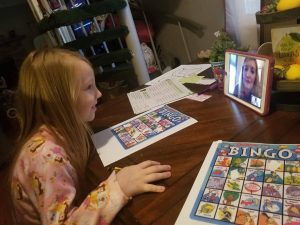By Ron Daley
Special to NKyTribune
First of Two parts
Rural Eastern Kentucky school districts utilized the innovative learning practices and digital teaching platforms they have used for years to jump-start the “Non-Traditional Instruction” (NTI) programming necessary when in-person classes were forced to shut down in mid-March because of COVI19.
School officials say it was not just their students who were learning because of the pandemic. And that unexpected positives have developed during the virus crisis.
“While this has been one of the most challenging times we have seen in our careers, watching our staff, parents and students rise to the challenge has made it also one of the most exciting times we have seen,” explains Lee County Superintendent Sarah Wasson.
“Our parents and other guardians have stepped up and not only have they become teachers themselves, but they have also been so supportive of the district in everything we have worked to do. And, our kids have stepped up and accepted their new normal and they are thriving.”
As one of the board members put it, “They are doing what we have taught them in school to do.”

This Harlan student is learning at home.
Harlan County Superintendent, Brent Roark, echoed this observation, “I am totally amazed at our parents, grandparents, and guardians. They have been extremely understanding, supportive, and gone above and beyond for us and their children. I especially commend those who have been on the front-line providing services during the pandemic and then coming home and taking on the added role of helping to educate them.”
Jeanne Ann Lee, director of the Harlan district-wide instruction programs, said an impressive thing she has witnessed with the interactions between teachers and students is they’ve shared who they are as a person, sharing family, pets, and their homes with their students while teleconferencing.
“Teachers relaxed their classroom persona and it has given their students an up-close and personal view of who they are outside the actual classroom. Students are truly seeing their teachers as real people who have some of the same likes that they have. They also seem to find some comfort and not afraid to ask for help or for replacement lessons, etc. from behind the computer screen. It has been a really good relationship builder.”
The availability of technology and the trained use of the technology has helped the rural, mountain districts be effective in NTI. Seventeen of the districts received technology funding, and professional learning in instruction as a part of the $30 million federal Race to the Top grant awarded to the Kentucky Valley Educational Cooperative and spread over six years.
In some respects, because of the grant, districts like Owsley have been ahead of many other state districts in NTI, in fact, they were a leader years ago.
Lincoln Spence, the principal at Owsley Co. Jr./Sr. High School says, “It has been the theme of our staff to not only rely on digital learning programs but rather use them as support for teacher-created, personalized instruction. Our teachers use Google Classroom to lead discussions, provide instructional videos (many times of themselves covering topics), and lead them through the instructional process as close to “in-person” teaching as possible. In addition to the daily Zooms with teachers (each grade-level team offers support for students with a daily schedule), several teachers/aides offer additional Zoom “Office Hours” to offer individual assistance.

“Our teachers also recently collaborated on a school-wide project, which had each student create a “Virtual COVID-19 Time Capsule” via Google Sites, Spence adds. Students included elements across all contents, even electives, into their respective projects. It was a very successful project, which our students enjoyed, as it was project-based, and relevant to the current world. This project, along with several other impressive projects/lessons, has provided students with the opportunity to continue a quality education during these challenging times.”
While COVID-19 is the catalyst for many districts in Kentucky embracing remote learning, Johnson County School District has been active in the Non-Traditional Instruction Initiative since the 2014-2015 school year.
Johnson County Superintendent, Thom Cochran said teachers across the district have taken advantage of the 1:1 ratio in 8th-12th grade by sending devices home with all students. Students on the elementary level were able to check out Chromebooks from their teachers, reducing the need for paper packets by 14%. For students with no internet access, Johnson County has made delivery of packets a priority, along with addressing the nutritional needs of all students as other districts are doing. Lunches are provided at several pickup locations across the district, and daily bus routes deliver meals to those in need of additional services.

Johnson County teachers have risen to the challenge utilizing Project-Based Learning with a cross-curricular approach, Cochran reports. Whether it is conducting live experiments via Google Meets or using apps such as EasyTeach to act as virtual whiteboards, teachers in the district have found unconventional ways to overcome instructional challenges due to COVID-19.
Cochran explained, “Not only do they welcome innovation, but teachers such as Andraya Preston at Johnson County Middle School believe it’s crucial to be cognizant of real-world events. On the week of March 9th-13th, Mrs. Preston, a 7th-grade Reading teacher in Team Gold, implemented Article Analysis groups. The topic was COVID19, and by Friday the students had enough background to understand when Governor Beshear called for the closure of all Kentucky schools due to the Coronavirus. The students in Team Gold continued to research the virus online and compared the advice of different authors, one of whom favored flattening the curve, while the other emphasized the importance of the economy.
“Prior to Johnson County’s scheduled Spring Break, the Team Gold students were challenged to create a culminating project illustrating how their lives were impacted by the COVID19 pandemic,” Cochran stated. “Like the staff of Johnson County Schools, the students rose to the occasion, showing snapshots of pets and family life, footage of stocked up pantries, and interviews of parents working from home in their Life in a Pandemic multimedia projects.”
To be continued
Ron Daley resides in Lexington. He was inducted into the Kentucky Journalism Hall of Fame in 2017. He is the strategic partner lead for KVEC.






















